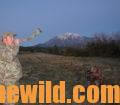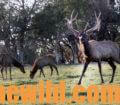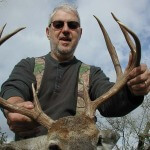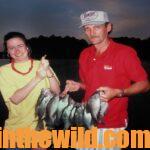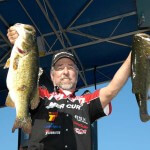Editor’s Note: Al Morris of Springville, Utah, has hunted elk for three decades and has guided for elk for two decades in Utah, New Mexico, Colorado, Wyoming, Idaho, Montana and Arizona. Morris has won the World Elk Calling Championship and the Best of the West Elk-Calling Contest, the Utah State Bugling Championship and the World Coyote Calling Championship.
During the main rut, 65% to 75% of cow elk will come into estrus. That’s when the big bulls move into the herd, establish their dominance and start breeding the cows coming into estrus. Most elk hunters like to hunt elk during the main rut because this is when the elk are the most vocal. If you chart when you hear the most bugling, generally that time will be from the September 7 to 15.
Then the bugling falls-off until the end of September. You’ll hear a lot of bugling and elk vocalization the first week of October when the second estrus begins. The satellite bulls will start trying to come into the herd, and the herd bulls will be running off the satellite bulls. You’ll see plenty of elk movement. The main rut is a great time to hunt in elk country.
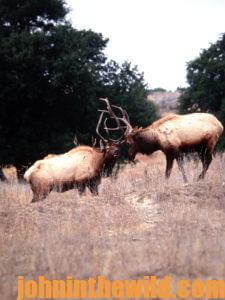
In the rut, the cows are competing to breed as much as the bulls. So, I’ve changed my rut tactics. In years past, I’d call-in the bulls, but now during the rut, I call-in the cows. I’ve found that one of the big mistakes most elk hunters make is because they want to harvest bulls, they call to the bulls. If you’ll change your thinking from calling bulls to calling cows, you’ll take more bulls during the main rut. The average age of the cow in my area in northwest Colorado is from 0- to 15-years old. If you can call in a 12- to a 15-year-old cow, when the cow comes in, the bull will follow her. That’s the good news.
The bad news is that in the pre-rut, there’s only one set of eyes trying to spot you. But during the main rut, you may have 10 to 30 pairs of eyes following you. Those eyes also have noses and ears. So, getting close to the herd really can be difficult during the main rut. That’s when I change my calling from sounding like a single, small bull and a single cow to calling as though I’m several-different cows in heat and their calves. If a bull’s bugle sounds like he’s big, mature and aggressive, then when I bugle back, I want to call back like a cow that’s older, more mature and more aggressive. In that bull’s mind, he pictures several cows and calves with a big, mature bull. If I can sound like a bull as big, strong, mature and willing to breed as the one that has his herd of cows with him, cows in that herd may decide to come check me out, thinking I’ve got bigger antlers and will be a better breeding partner than the bull they’re with now. If I can get those cows’ attention, the herd bull’s got a big problem. He’s got to keep all his girlfriends from coming over and checking me out.
If I can get that lead cow or even a calf to start coming toward me, the old herd bull will get so upset that he’ll run and try to herd the calf or the cow back into his harem. Many times he’ll swing right in front of me and my hunter. I’ve been highly successful using this tactic of calling the cows, instead of the bulls, hoping to get the cows interested enough to come over and take a look at me. If the cows begin moving toward me, and that bull’s upset, oftentimes he’ll come-in close enough for me to get a shot at him.
If you get 300 yards from a herd and all the cows pick-up their heads and leave, then this tactic probably isn’t the right one. However, if you call to enough elk, eventually one of those cows will come to you. If you can get closer than 300 yards and start giving soft cow calls, the cows often will look-up to try to spot you. But then they’ll return to their feeding, which means you can move-in closer and start giving an estrus whine call. If the cows stop feeding and look-up but start feeding again, more than likely because you’re closing the distance to them and coming to the herd,they’ve accepted you as a cow that’s just strayed out to the edge of the herd. Elk have a specific tolerance level. If you can get them to accept you as you move closer to them, at some point, they won’t feel threatened by you.
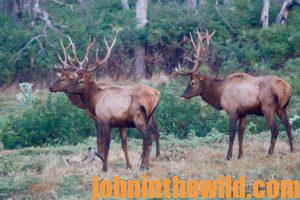
When you’re calling from the farthermost point, say about 300 yards from the herd, you want to set-up a cow-calf dialogue, like a cow and a calf are talking to each other. If the herd doesn’t run off, then move-in closer, and give a cow call. When the cows in the herd hear this estrous cow call close to their herd bull, they’ll get upset. Most of the time the older cow in the herd will start moving toward that estrous cow call to run-off that cow. With her ears laid back, you can tell by her posture that she’ll whip this intruder cow. This cow-elk fight is like a catfight between two women fighting over the same man. Although you rarely will hear elk hunters discuss this type of calling, I’ve seen it work.
Remember, if you can manage the cows and get them to do what you want them to do during the main rut, which is come toward you and check you out, then the bull will pursue the cows. If you don’t get the lead cow to come over to you, you’ve got to gain ground and position yourself within 100 yards of the herd. If the herd’s comfortable with your calling, establish a dialogue using a variety of calf and cow calls. If you use four or five-different calls, one of those calls usually will trigger either a cow or a bull to move toward you. To call to elk, let the elk tell you what type of calling they want to hear. If you can blow an elk call without offending the elk, then they’re telling you that you’re saying what they want to hear. However, if you blow a call, and the elk put their heads up quickly and begin acting nervous, stop saying anything. Let the herd calm back down, and use a different call. If the herd seems to be offended by cow calls, after the herd settles back down, I’ll start bugling. When I’m hunting during the rut, I often will blow my best contest call to sound like a big, dominant bull elk. I’ve had a herd pick-up and run when I’ve done that, but I’ve also had a herd quit feeding and come right to me. As all the cows move toward me, the bull will circle in front of them to cut the cows off before they reach me. He’ll end up standing right in front of them and me.
There’s no one set way to call elk during the rut, and I don’t know of one individual call that always works. But if you’ll take the temperature of the elk one step at a time, as you close-in on them and determine the type of calling they like and don’t like, your opportunities of getting-in close and taking an elk are much greater. You’ve got a really-good chance of taking the bull, if you can get inside that 300-yard barrier with your calling and not spook the elk; move to within 200 yards, start calling again and still not spook the elk; or move to within 100 yards, call the elk, and they don’t run off.
What to Do When a Cow Comes-In During the Main Rut But the Bull Elk Doesn’t:
Sometimes when this main-rut plan works, the cow will move toward you, but the bull won’t go after her. Or, he may swing around in front of her and cut her off. When the cow’s traveling to me, and I know for certain she can’t see or smell me, I’ll start cow calling. Many times she’ll begin calling. You almost can hear what the cow’s saying as she’s coming in your direction. You can tell by the inflection in her voice that she’s saying, “Hey, girlfriend, you better shut-up.” As soon as that lead cow vocalizes, the entire herd will move toward you. I’ve been amazed at how many times I’ve been able to call-in the entire herd like this, and my hunter’s then gotten the shot. However, for every one time I’ve called-in the entire herd, and we’ve gotten a shot at the bull elk, there have been four times when the herd’s come-in, and one of the cows either has seen or smelled us. Generally, only one or two of the animals will spook. As long as the animal that spooks isn’t the lead cow, the dominant bull or an important cow in the herd, then you often can catch-up, begin calling, work your way in close a second time and even have a third chance at the herd.
To learn more about elk hunting, check out John E. Phillips’ books, “PhD Elk: How to Hunt the Smartest Elk in Any State” and “Secrets for Hunting Elk,” both available at
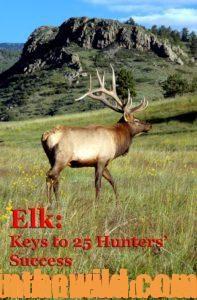
http://amzn.to/WkbAWa and http://amzn.to/WGb9le.
Tomorrow: Hunt the Second Rut and the Post Rut for Elk and Choose an Outfitter

